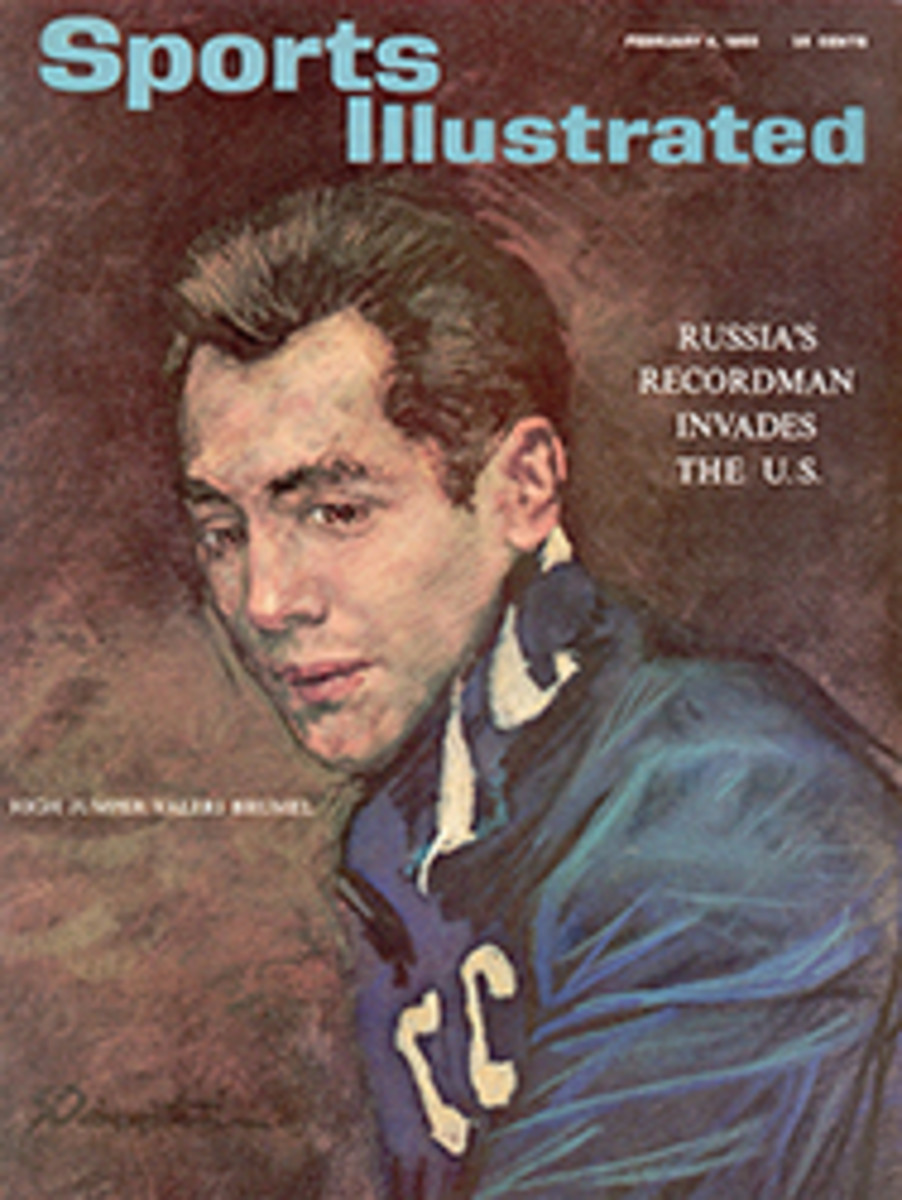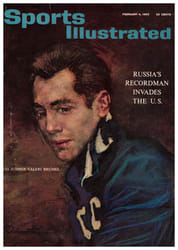
TWO WAYS TO BE RANKED 1-2
Chicago Stadium has a seating capacity of 18,000 and the fire department permits another 2,000 to stand, so it may never be determined how a crowd estimated at 24,000 people got into its dark confines last Saturday night. But there they were, sitting in the aisles, standing on ramps, holding onto girders, a bell-ringing, bugle-blowing, banner-waving crowd gathered to watch two basketball games involving the top three teams in the country—Cincinnati, Loyola of Chicago, and Illinois. More than that, the event presented a chance to study two contrasting styles of play. In the first game second-ranked Loyola ran, ran, ran and shot, shot, shot as it wore down Santa Clara 92-72. In the second game top-ranked Cincinnati, playing in its slow, methodical manner, beat third-ranked Illinois 62-53. If neither game was a thriller, the huge crowd didn't mind. Watching the top three in action was worth the price of a ticket, even the scalpers' asking price—$30.
The season's best doubleheader by far was arranged almost a year ago during the NCAA tournament in Louisville by a short, squat, balding man of 52 named Arthur Morse. Morse is a Chicago lawyer, but he is also a promoter—his official title is assistant to the athletic director at Loyola—and it is a role that he fits well. He wears black horn rimmed glasses, smokes a cigar half his size and is incapable of standing in one spot for more than a sentence. He is Mike Todd reborn.
For several years Morse has scheduled doubleheaders in Chicago Stadium involving Loyola and Illinois. He picked Santa Clara for this year's first game, partly because the school had done him favors in the past, but mostly because the team's deliberate style of play would contrast well with Loyola, which hasn't had a deliberate thought in years. Doug Mills, the athletic director at Illinois, told Morse to get Kentucky for the second game, but Morse wasn't sold. "I finally decided that Cincinnati had it and that Kentucky did not," says Morse—a fact that Mills himself might have been privately considering all the time.
The doubleheader was all set when Cincinnati's athletic director, George Smith, suddenly remembered that university rules forbid the team to play an away game in the week following exams. Smith told Morse he would have to get permission when he returned to Cincinnati in a week or two. Art Morse is not a man to wait even a minute or two. He pushed Smith into a Louisville phone booth and didn't let him out until Smith had received permission from every member of the athletic board. "That's how we got it," beamed Morse last week. "And boy have we ever got it."
The double catch
Morse, indeed, did have it. He had Cincinnati, the reigning national champion, winner of 32 straight, master of the art of careful basketball. In Illinois, he had the other end of the strategy see-saw, a helter-skelter, free-lance team of shooters that had averaged 88 points a game, 40 more than Cincinnati was in the habit of giving up.
Only one team had scored more points a game than Illinois, and that was Loyola of Chicago, with 97. Loyola won 17 straight games to earn its No. 2 ranking, and if its opposition was not overly impressive its margins of victory were.
In Chicago before the doubleheader, people were kidding Art Morse about failing to get Arizona State, the fourth-ranked team, to play Loyola, but Morse was happy enough to have Santa Clara, a steady team with an unspectacular 9-4 record but a very impressive win over eighth-ranked Wichita. Santa Clara's deliberate attack promised Loyola an interesting evening.
Santa Clara, its gangling young men wearing light raincoats and loafers, landed in Chicago at 6 Friday morning with the temperature at zero. The players spent the morning trying, but in most cases failing, to sleep, then staggered out to the Loyola gymnasium for a workout. Coach Dick Garibaldi was worried about Loyola's full-court press. "I hear that Loyola's press had one team so rattled that when a Loyola guard stomped his foot on the court, the opposing player threw the ball out-of-bounds. If Loyola does that to us, we have a couple of guys who may faint," he said.
In another part of the gym George Ireland, the Loyola coach, sat at his desk. "We're really hurting," he complained. "Ron Miller, a starter, and Paul Robertson, our sixth man, are both injured. That may ruin our press. I'm dead, no kidding. But I suppose they're down there working against our press right now. Funny how that gets people worried. This is one club the press may bother." Ireland pivoted in his chair, reached into a file cabinet and produced a neat folder labeled "Santa Clara." He pulled out a paper and read. "Real pressure can be put on backcourt men since neither is an exceptional ball handler." Coach Ireland put the paper away. "Well, we'll see."
Shortly after Santa Clara left for its hotel and bed, the Cincinnati team arrived at the gym and went through a rugged hour drill. "They need work," said Coach Ed Jucker. When the practice was over Jucker and his boys boarded their bus, which promptly got stuck in the snow. Jucker moaned. Then the bus got lost. Jucker, who believes such things are omens, moaned again.
That evening the coaches of the top three teams—Jucker, Ireland and Harry Combes of Illinois—were interviewed together. Ireland and Combes, both of whom swear by lickety-split basketball, needled Jucker. "I saw a column in the paper today," said Ireland. "The writer says that Cincinnati's style of play is as attractive as kissing a wet mop." Ireland laughed. Combes laughed. The onlookers laughed. Jucker smiled, but the smile could have slit a throat. When the interview was over the three coaches shook hands like three ministers of state. Art Morse rushed up and tried to embrace all of them at once, but each was already headed in a separate direction.
On Saturday morning Harry Combes sat in his hotel suite sucking on a cough drop. "I've been fighting the flu all week," he said. He coughed violently, his lean body shaking. "This is a new cough drop with a liquid center—the liquid gets you."
Combes and most of the Illinois team had seen Cincinnati's game against Bradley in Peoria. At the time, he was asked how Cincinnati looked. "Well, it depends on what kind of game you came to see," he had answered. "Both teams were well disciplined." What Combes meant is that if you like defensive basketball that's your business.
The last spectator who could squeeze in had hardly gotten a firm hold on an I beam in the rafters of Chicago Stadium on Saturday night when Santa Clara's Dick Garibaldi discovered he had been worrying about the wrong thing. The Santa Clara guards handled Loyola's press with ease and cut up the rest of the Rambler defense—this being an aspect of the game that apparently bores the Chicago team. What Santa Clara never got close to was a rebound. Almost every Loyola shot, if missed, was followed by a series of taps. Santa Clara got only 41 rebounds, Loyola's high jumpers came down with 64.
Still, with 12 minutes to go, the score was tied 59-59. Then Loyola made eight straight points, wrapped up the game and began playing for headlines. It used a full-court press down to the final whistle as it ran up the score, and seemed disappointed with only 92 points.
The second game was equally revealing, for it showed that on certain nights, at least, Cincinnati can be had. After 10 good minutes the normally crisp Bearcat offense went limp. Then Cincinnati's fine guard, Tony Yates, got himself in foul trouble—an unheard-of development—and the Bearcat defense began lagging too, perhaps showing the effect of the examination week layoff. But what Cincinnati essentially displayed was a dulling supercaution instead of its usual grand élan.
However, if Cincy was troubled, Illinois was a couch case. Not all the liquid-center cough drops in Chicago could have subdued Coach Combes's strangled cries as his normally excellent bunch of marksmen took 35 shots in the first half and managed to sink just nine. This unexpected display of blah sent Illinois off the court trailing by 33-23. The Illini tried to come back in the second half, but never hit their normal shooting stride. Illinois did cut the Cincinnati lead to four points, 34-30, thanks largely to the play of Tal Brody, a superb sophomore guard who somehow managed to keep up with Yates, run his own team, too, and turn in perhaps the most impressive single performance of the night. But when the score got that close, Cincinnati slowed the play down. The Bearcats' excellent shot, Ron Bonham, took what field-goal tries Cincy cared to risk. Finally, with five minutes left and a nine-point lead, Cincinnati shifted from slowdown to deep freeze, and refused to shoot at all. The boos rattled the stadium roof, but nothing rattles a Cincinnati stall and Illinois was beaten. As Ed Jucker led the champions off the floor they were heartily booed some more. "Why were they all booing?" asked Jucker in the locker room, genuinely puzzled. "I mean, the object is to win. What are we supposed to do? Give them the ball?" He had a point. His team had suffered through an off night against a major foe and still come away with a victory.
The basketball-wise crowd at the stadium filed out into the snow feeling just a little disappointed. It had indeed seen the country's top three teams, but none of them had actually performed as well as they could. Yet it did come away with one big, exciting question to ponder. If the country's best offense, Loyola, played the country's best defense, Cincinnati, who would win? The teams won't face each other this year—unless they meet in the NCAA tournament—but you can bet that Matchmaker Morse is already hard at work trying to arrange just that game for next season.
PHOTO
Looking unnerved, but actually unshakable, high scorer Bonham sets to sink a foul shot.

